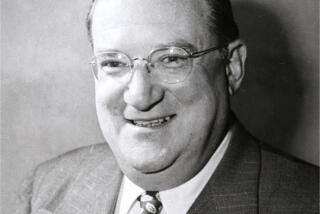Hall Inductees Talk of Respect for Family, Game
- Share via
COOPERSTOWN, N.Y. — Wade Boggs cried when he acknowledged his father, who turned a scrawny kid into one of the game’s toughest outs by teaching him that inside-out swing.
Ryne Sandberg was smooth, stoic and flush with reverence for the game.
Four decades after they once dreamed of baseball greatness, Boggs and Sandberg were inducted Sunday into the Baseball Hall of Fame to the cheers of thousands of Boston Red Sox and Chicago Cub fans.
“There were many stops along the way,” said Boggs, who began playing minor-league baseball in Elmira, N.Y., in 1976. “But today that train has pulled into Cooperstown, and I’ve found this family here at the Hall of Fame.”
Boggs, who batted left-handed, was an undersized hitter who didn’t attract much attention even though he finished his senior year at Plant High in Tampa, Fla., on a 26-for-33 tear.
He was drafted in the seventh round by the Red Sox and then spent more than five seasons in the minors before compelling Boston to promote him in 1981 after he led the International League in batting.
Boggs learned the swing that produced 3,010 hits from his father, Winfield, a fast-pitch softball star.
He learned well, going on to hit .300 or higher 15 times and finishing with a .328 career average. He was the only player in the 20th century with seven straight 200-hit seasons.
And when it came time to pay tribute to his 80-year-old father, Boggs broke down as his dad, too, brushed away tears.
“Daddy, I wouldn’t be up here without you, my mentor, my idol,” Boggs said.
Sandberg, a darling of Cub fans because he excelled in every facet of the game as a second baseman who shunned the spotlight, said he became a Hall of Famer because he respected the game. And the 48 Hall of Famers sitting behind seemed to nod in unison.
“A lot of people say this honor validates my career,” said Sandberg, who was picked in the 20th round of the 1978 amateur draft by the Philadelphia Phillies. “But I didn’t work hard for validation. I didn’t play the game right because I saw a reward at the end of the tunnel. I played it right because that’s what you’re supposed to do, play it right and with respect. Turning two is more important than knowing where to find the little red light on the dugout camera.”
Although Sandberg began at shortstop, he eventually was switched to second and blossomed in 1984, two years after the Phillies traded him to the Cubs.
The trade gave Sandberg a chance to play every day, and he quickly quieted the skeptics who thought he was too tall at 6 feet 2 to play second. He won the first of nine consecutive Gold Gloves, establishing a major league record of 123 consecutive errorless games over two seasons.
Sandberg won MVP honors in 1984, hitting a career-high .314 with 19 homers, 84 runs batted in, 114 runs, 32 stolen bases, and only six errors in 156 games.
Also enshrined were longtime San Diego Padre announcer Jerry Coleman, winner of the Ford C. Frick Award presented annually for major contributions to baseball broadcasting; and veteran sportswriter and broadcaster Peter Gammons, recipient of the J.G. Taylor Spink Award, presented annually for meritorious contributions to baseball writing.
More to Read
Go beyond the scoreboard
Get the latest on L.A.'s teams in the daily Sports Report newsletter.
You may occasionally receive promotional content from the Los Angeles Times.










